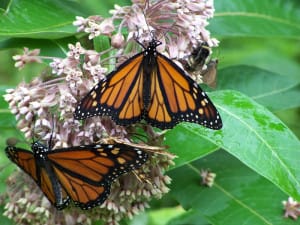by Jérôme Rigot, PhD
 |
USDA Forest Service |
USDA researchers have identified the neonicotinoid insecticide clothianidin as a likely contributor to monarch butterfly declines in North America. The USDA research was published online April 3rd, 2015 in the journal Science of Nature.
Neonicotinoids have been strongly implicated in pollinator declines worldwide; they are neurotoxins that are partially banned in the European Union. A recent report indicates (see references at the end of full article) that neonicotinoids, such as clothianidin (Bayer), are a particular hazard because, unlike most pesticides, they are soluble molecules. From soil or seed treatments they can reach nectar and are found in pollen.
Neonicotinoids are now the most widely used pesticides in the world. Up until now there has been negligible research on the effects of neonicotinoids on butterflies. This new report is therefore the first to link neonicotinoids to monarch butterfly survival and reproduction.
In their experiments the USDA researchers showed that clothianidin can impact monarch caterpillars at doses as low as 1 part per billion (ppb). The effects seen were on caterpillar size, caterpillar weight, and caterpillar survival. The lethal concentration (LC50) was found to be 15 ppb.
In this research project, the caterpillars were exposed to clothianidin-treated food for only 36 hours. However, the researchers noted that in agricultural environments caterpillar exposure would likely be greater than in the experimental conditions set for this project; furthermore, in nature butterfly caterpillars would also be exposed to other pesticides, including other neonicotinoids.
In sampling experiments from corn-growing areas in South Dakota the researchers found on average over 1 ppb clothianidin in milkweed plants.
Based on this study’s results, the USDA researchers concluded that “neonicotinoids could negatively affect larval monarch populations.” They added, “Although preliminary, this study clearly shows that monarch larvae are exposed to clothianidin in the field at potentially harmful doses of the toxin.”
More on this from Independentsciencenews.org at:
http://www.independentsciencenews.org/news/new-research-links-neonicotinoid-pesticides-to-monarch-butterfly-declines/
Full article: http://www.bioscienceresource.org/wp/wp-content/uploads/2015/04/Pecenka-and-Lundgren-2015-Early-On-line.pd
Comment from Cornucopia scientist Jérôme Rigot, PhD, Farm and Food Policy Analyst:
The study states: “The lethal concentration (LC50) was found to be 15 parts per billion.”: This is a very low level; however, the implications are that much lower levels of neonicotinoids as well as synergistic effects with other pesticides at very low levels (1 ppb or less), as suggested in the text, would significantly and negatively affect caterpillars’ health.
Extrapolating from the study results, the synergistic action of pesticides, even at levels below 1 ppb (levels that may not be detected by the EPA’s current analytical equipment), can significantly and detrimentally impact the health of organisms (including humans) that come in contact (e.g., ingest) with a vegetable or fruit that has been sprayed from seed to harvest by a variety of pesticides and likely is covered by and/or contains a number of pesticide residues at trace levels.

